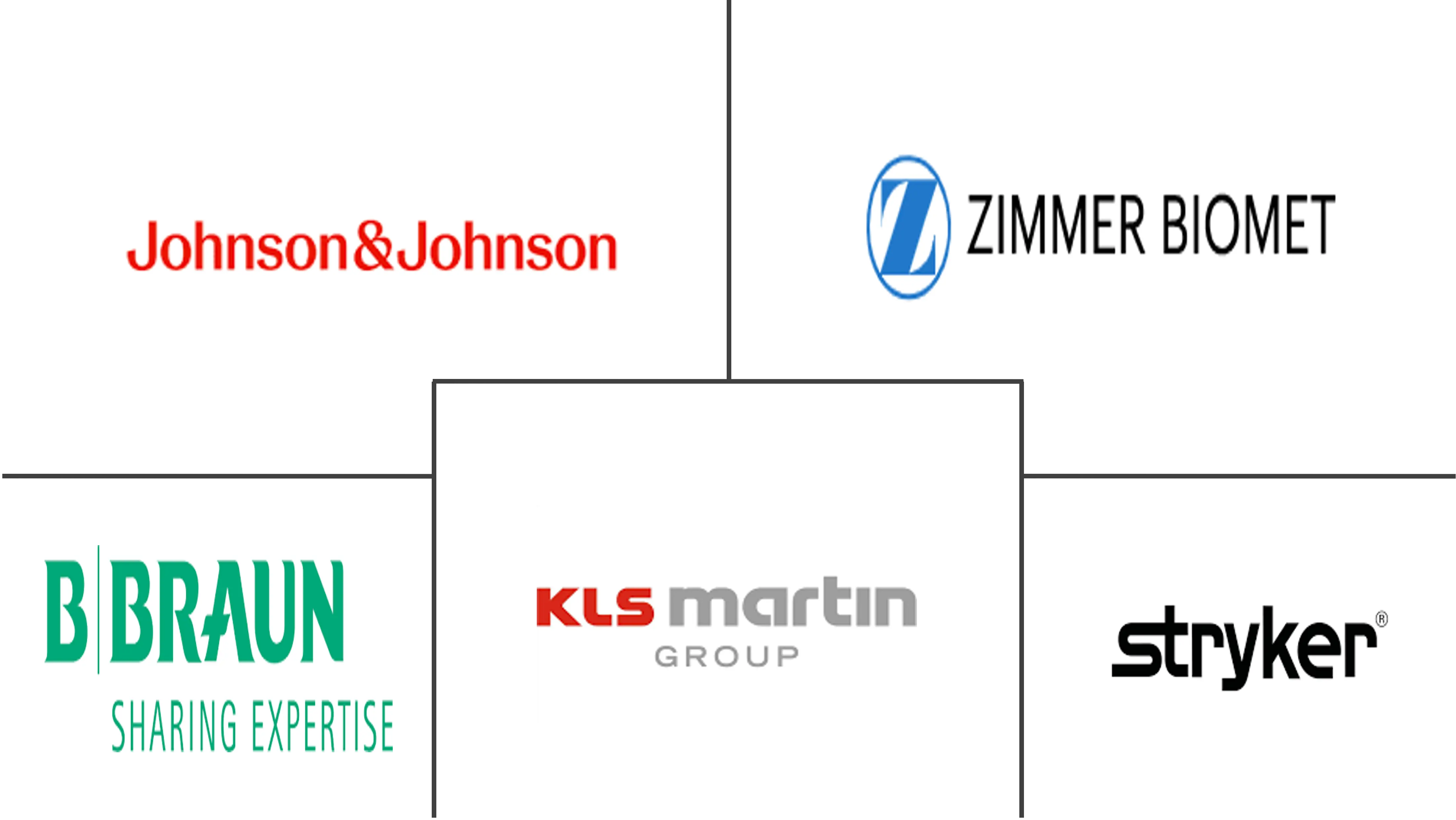Global Cranial Implants Market Size and Share
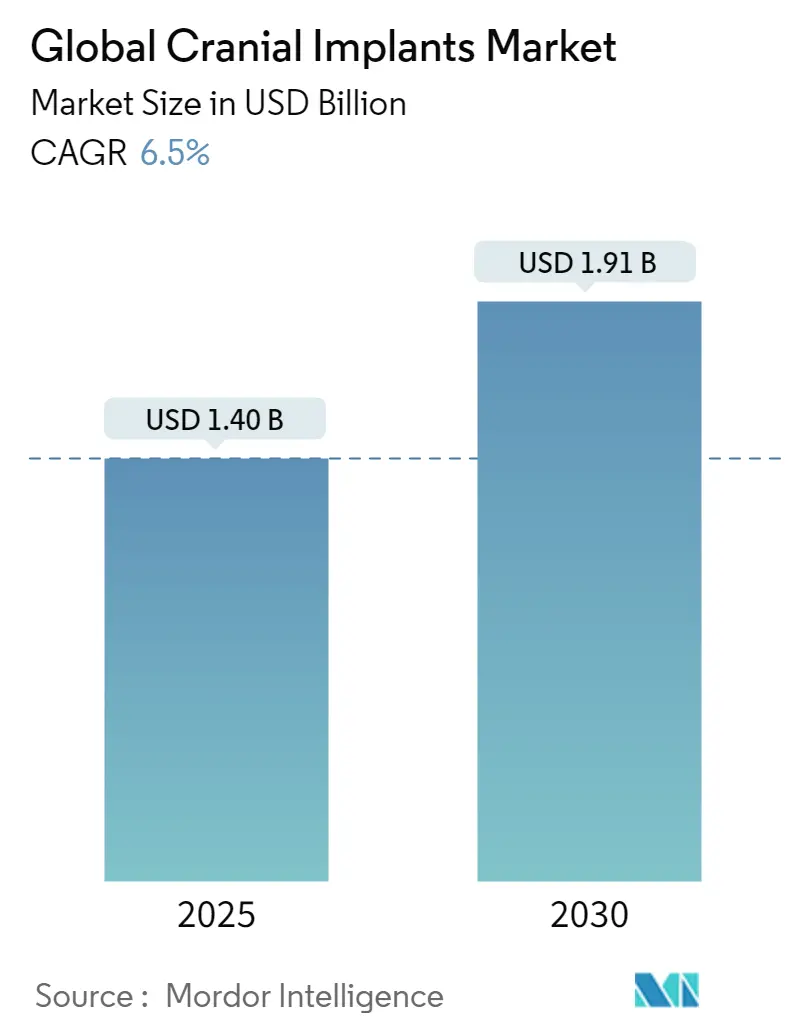
Global Cranial Implants Market Analysis by Mordor Intelligence
The cranial implants market stands at USD 1.40 billion in 2025 and is projected to expand to USD 1.91 billion by 2030, advancing at a 6.5% CAGR. Robust demand stems from a steady rise in traumatic brain injuries, broader neurosurgical capacity in emerging economies, and a decisive shift toward 3-dimensional patient-specific manufacturing. Hospitals remain the anchor customer base, yet specialty neurosurgery centers are scaling rapidly as payers reward high-outcome facilities. Titanium retains primacy because of decades of clinical proof, but polymeric alternatives such as PEEK gain traction as surgeons prioritize artifact-free imaging. Technology adoption also pivots: conventional machining still fills high-volume needs, yet 3-D printed solutions are winning complex cases because they reduce operative time and revision risk. Regionally, North America leads revenue, while Asia-Pacific generates the fastest growth on the back of infrastructure build-outs and regulatory modernization that shorten device-approval cycles.
Key Report Takeaways
By material, titanium accounted for 52.76% of cranial implants market share in 2024, while PEEK is on track for the fastest 7.35% CAGR through 2030.
By technology, conventional machining held 48.61% of the cranial implants market size in 2024; 3-D printing is projected to expand at 7.95% CAGR to 2030.
By end user, hospitals commanded 69.68% of revenue in 2024, whereas specialty neurosurgery centers are advancing at an 8.25% CAGR through 2030.
By geography, North America generated 41.23% of 2024 sales; Asia-Pacific is forecast to record an 8.75% CAGR to 2030.
Global Cranial Implants Market Trends and Insights
Driver Impact Analysis
| Driver | (~) % Impact on CAGR Forecast | Geographic Relevance | Impact Timeline |
|---|---|---|---|
| Rising incidence of cranial trauma & neurosurgical procedures | +1.8% | Global, with higher impact in North America & Europe | Medium term (2-4 years) |
| Advancements in 3-D printing for patient-specific implants | +1.5% | Global, early adoption in North America & Europe | Long term (≥ 4 years) |
| Superior clinical outcomes of titanium & PEEK implants | +1.2% | Global | Medium term (2-4 years) |
| Expanding neurosurgical infrastructure in emerging economies | +1.0% | APAC core, spill-over to MEA | Long term (≥ 4 years) |
| Augmented-reality assisted implant positioning | +0.7% | North America & EU, selective APAC markets | Medium term (2-4 years) |
| Military neuro-protection R&D boosting bioceramic adoption | +0.5% | North America & Europe, defense sector focus | Long term (≥ 4 years) |
| Source: Mordor Intelligence | |||
Rising Incidence of Cranial Trauma & Neurosurgical Procedures
Worldwide, roughly 69 million traumatic brain injuries occur each year, and severe cases often necessitate cranioplasty reconstruction. Aging populations, higher motor-vehicle density, and organized sports elevate the clinical burden. Defense research into neuro-protection further amplifies demand as military surgeons require dependable synthetic plates for battlefield injuries. At the hospital level, dedicated neuro-trauma centers consolidate complex cases, creating predictable procurement cycles for high-volume suppliers. Because trauma incidence is weakly correlated with economic cycles, the cranial implants market enjoys defensive-healthcare status that supports long-term planning by manufacturers and health systems alike.
Advancements in 3-D Printing for Patient-Specific Implants
Additive manufacturing transforms a one-size-fits-all procedure into tailored reconstruction. The 2024 FDA clearance of 3D Systems’ PEEK cranial plate proved the regulatory viability of polymeric additive implants. Surgeons now access cloud-based design tools that convert CT data into a ready-to-print file in minutes, trimming operating time and anesthesia exposure. Hospitals gain negotiating leverage with insurers by citing shorter length of stay and higher patient-satisfaction indices. Meanwhile, lattice infills and variable-thickness walls impossible in milling become routine, lowering weight and optimizing biomechanical stress paths. Suppliers that combine artificial intelligence with in-house printers are building widening competitive moats while legacy machine shops face commoditization risk.
Superior Clinical Outcomes of Titanium & PEEK Implants
Titanium plates achieve osseointegration rates above 95% within six months and remain the go-to solution for multi-fragment defects Journal of Neurosurgery. PEEK’s radiolucency allows artifact-free post-operative CT scans, helping clinicians track healing without interference. Both materials can receive hydroxyapatite coatings that cut recovery time from 12 weeks to 8 weeks in controlled trials, leading procurement boards to prioritize products with proven surface treatments. Patients also report less thermal sensitivity with PEEK, enhancing post-surgical quality-of-life scores that feed directly into value-based purchasing contracts.
Restraint Impact analysis
| Restraint | (~) % Impact on CAGR Forecast | Geographic Relevance | Impact Timeline |
|---|---|---|---|
| High cost & limited reimbursement for customized implants | -0.8% | Global, acute in emerging markets | Short term (≤ 2 years) |
| Post-operative infection leading to implant removal | -0.5% | Global | Medium term (2-4 years) |
| Regulatory ambiguity for bio-resorbable scaffold materials | -0.4% | Global, regulatory uncertainty in EU & APAC | Medium term (2-4 years) |
| Supply-chain risk for medical-grade PEEK resin | -0.3% | Global, concentrated supplier base | Short term (≤ 2 years) |
| Source: Mordor Intelligence | |||
Expanding Neurosurgical Infrastructure in Emerging Economies
China’s healthcare reform earmarks USD 1.4 trillion through 2030 for new facilities, including trauma hubs in tier-2 cities National Health Commission of China. India’s National Medical Devices Policy targets 15% annual growth and encourages joint ventures for localized implant production Government of India[1]Source: Government of India, “National Medical Devices Policy 2025,” india.gov.in. As intraoperative imaging reaches community hospitals, surgeons adopt advanced cranioplasty techniques earlier in their careers. Gradual expansion of private health insurance in Southeast Asia further softens cost barriers, broadening the cranial implants market beyond major metropolitan centers.
High Cost & Limited Reimbursement for Customized Implants
United States Medicare reimburses USD 1,012.77 for CPT 62140, often less than one-quarter of a patient-specific PEEK implant’s list price. In France, a 25% reimbursement cut for orthopedic hardware effective 2025 exemplifies broader cost-containment efforts. The approval labyrinth for private-insurance pre-authorizations adds administrative friction that can delay surgeries. Emerging markets rely heavily on out-of-pocket spending, forcing surgeons to choose between autologous grafts and higher-priced synthetics. Payers increasingly demand real-world outcome data, favoring suppliers with large post-marketing registries over smaller niche entrants.
Post-Operative Infection Leading to Implant Removal
Surgical-site infection rates after cranioplasty vary between 2% and 15% and often necessitate complete hardware removal. Biofilm formation can defeat systemic antibiotics, raising interest in antimicrobial coatings, yet regulatory approval for such coatings is both time-consuming and costly. Financial repercussions include extended hospitalization, repeat imaging, and potential litigation, which heighten the caution of risk-averse hospital committees. Material differences matter: studies indicate lower bacterial adhesion on PEEK surfaces, subtly shifting surgeon preference toward polymer plates in high-risk cohorts.
Segment Analysis
By Material: Titanium Dominance Faces PEEK Innovation Challenge
Titanium held 52.76% of cranial implants market share in 2024, underscoring its entrenched clinical acceptance. The segment benefits from abundant surgeon familiarity and favorable mechanical strength-to-weight ratios. PEEK, however, is the fastest-expanding material, advancing at a 7.35% CAGR as radiologists favor its imaging clarity. In revenue terms, PEEK’s portion of the cranial implants market size is forecast to widen steadily through 2030, propelled by FDA-cleared patient-specific solutions.
Hybrid constructs that embed titanium meshes inside PEEK shells mitigate stress shielding while preserving radiolucency, offering a middle path for surgeons wary of fully polymer implants. PMMA retains a niche in low-resource settings because of low unit cost, while resorbable polymers gather interest for pediatric cases where skull growth continues post-implantation. Advanced surface texturing and plasma coating technologies are improving bone ingrowth across all materials, potentially blurring performance gaps and intensifying competition within the cranial implants market.
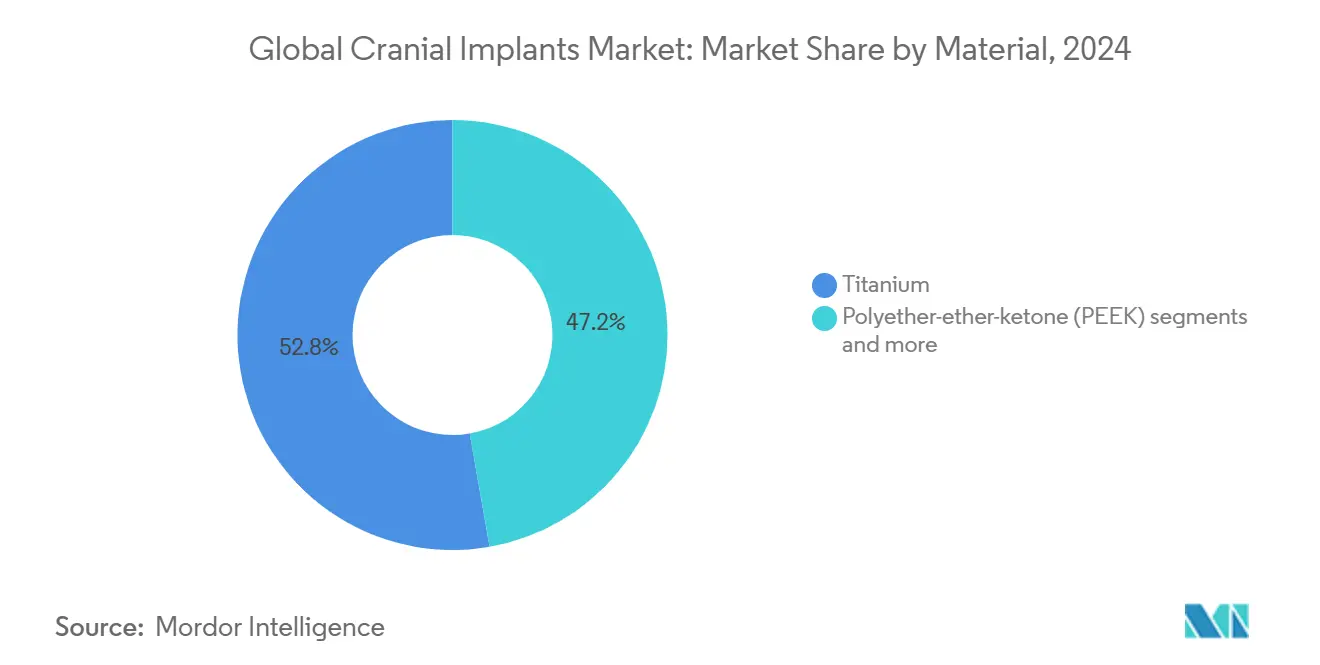
Note: Segment shares of all individual segments available upon report purchase
By Technology: 3-D Printing Disrupts Conventional Manufacturing
Conventional machining generated 48.61% of 2024 revenue, yet 3-D printing is advancing at 7.95% CAGR, overtaking milled implants in high-complexity cases. Hospitals adopt end-to-end digital workflows that integrate imaging, virtual surgical planning, and additive production, compressing lead times from weeks to hours. As a result, patient-specific plates are increasingly indicated even in trauma settings where time previously favored stock implants.
Quality assurance remains a focal point: industrial computed tomography now inspects each lattice-filled plate for voids and residual powder. CAD/CAM milling continues to serve standardized geometries endowed with volume discounts. Nonetheless, artificial-intelligence algorithms embedded in design software automatically predict stress-hotspots, fine-tuning thickness only where needed. This optimization lowers material costs and appeals to payers looking for quantifiable value, reinforcing the tilt toward additive techniques within the cranial implants market.
By End User: Specialty Centers Drive Market Evolution
Hospitals controlled 69.68% of 2024 revenue owing to emergency-department captures and established neurosurgical units. Yet specialty neurosurgery centers, advancing at an 8.25% CAGR, are reshaping referral patterns through focused expertise and integrated imaging suites. Higher procedural volumes per surgeon sharpen learning curves and elevate outcome metrics, driving insurers to route elective cases to these facilities.
Ambulatory surgical centers gain traction for less complex cranioplasties, aided by minimally invasive techniques and improved anesthesia recovery. Point-of-care 3-D printing within these facilities cuts logistics overhead and supports just-in-time inventory philosophies. Partnership agreements between specialty centers and implant makers encompass clinical trials, generating post-marketing data that meet evolving reimbursement criteria. These dynamics collectively reinforce broader decentralization trends inside the cranial implants market.
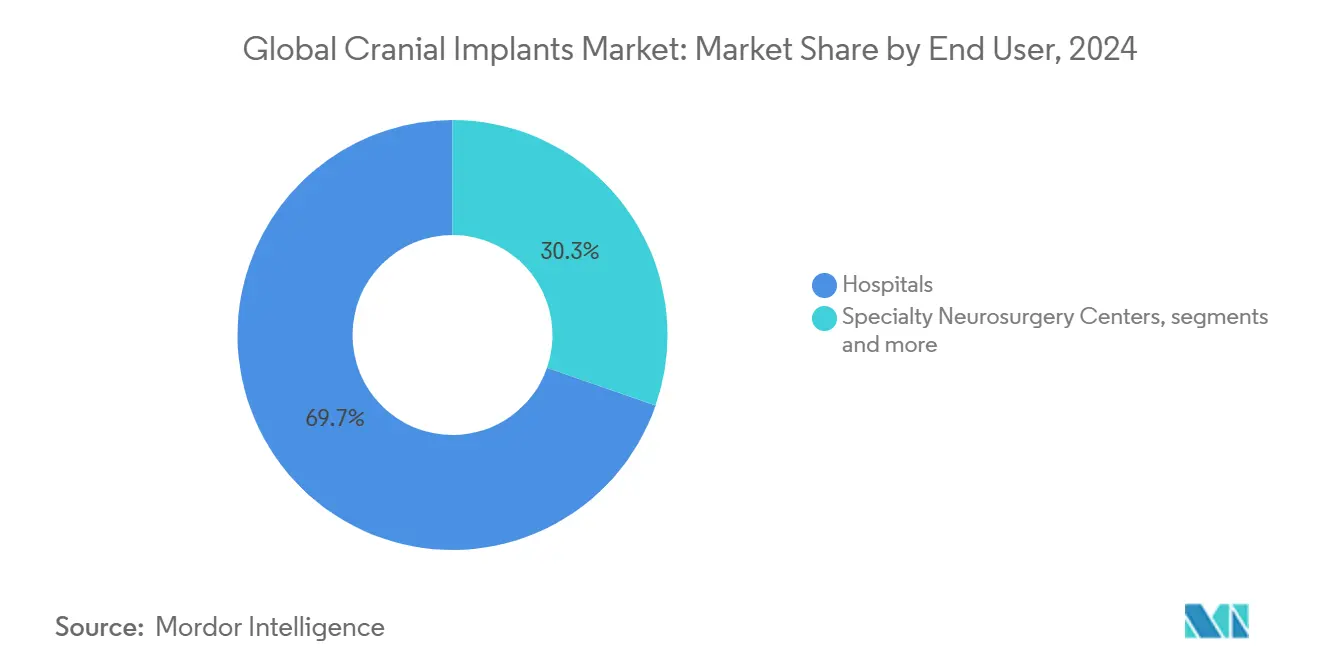
Geography Analysis
North America generated 41.23% of 2024 revenue, anchored by Medicare coverage and an installed base of high-end imaging systems. Academic hubs such as Mayo Clinic and Johns Hopkins also function as innovation incubators, accelerating early adoption of augmented-reality navigation during cranioplasty procedures. Nevertheless, mounting payer pressure keeps list-price inflation in check, compelling suppliers to justify premium tariffs with demonstrable reductions in revision rates.
Asia-Pacific is the fastest-growing region at an 8.75% CAGR, propelled by multibillion-dollar public-hospital buildouts in China and India. Streamlined device-approval pathways and incentives for local production shorten time to market for both multinationals and domestic entrants. Japan and South Korea lead surgical robotics penetration, fostering a virtuous cycle of precise implant fit and lower complication rates. Rising household incomes and broader private-insurance availability make elective cranioplasty more accessible, sustaining momentum in the cranial implants market.
Europe exhibits steady but slower growth as the Medical Device Regulation raises compliance costs. Germany and France spearhead evidence-based procurement, obliging sellers to produce longitudinal outcome data. Nordic countries, which have digitized health records extensively, adopt patient-specific implants quickly because their single-payer systems can evaluate real-world value at national scale. In the Middle East and Gulf states, medical-tourism programs underpin premium implant demand, while African markets remain nascent but benefit from international trauma-care initiatives. Collectively, these regional nuances demand tailored go-to-market strategies from companies active in the cranial implants market.
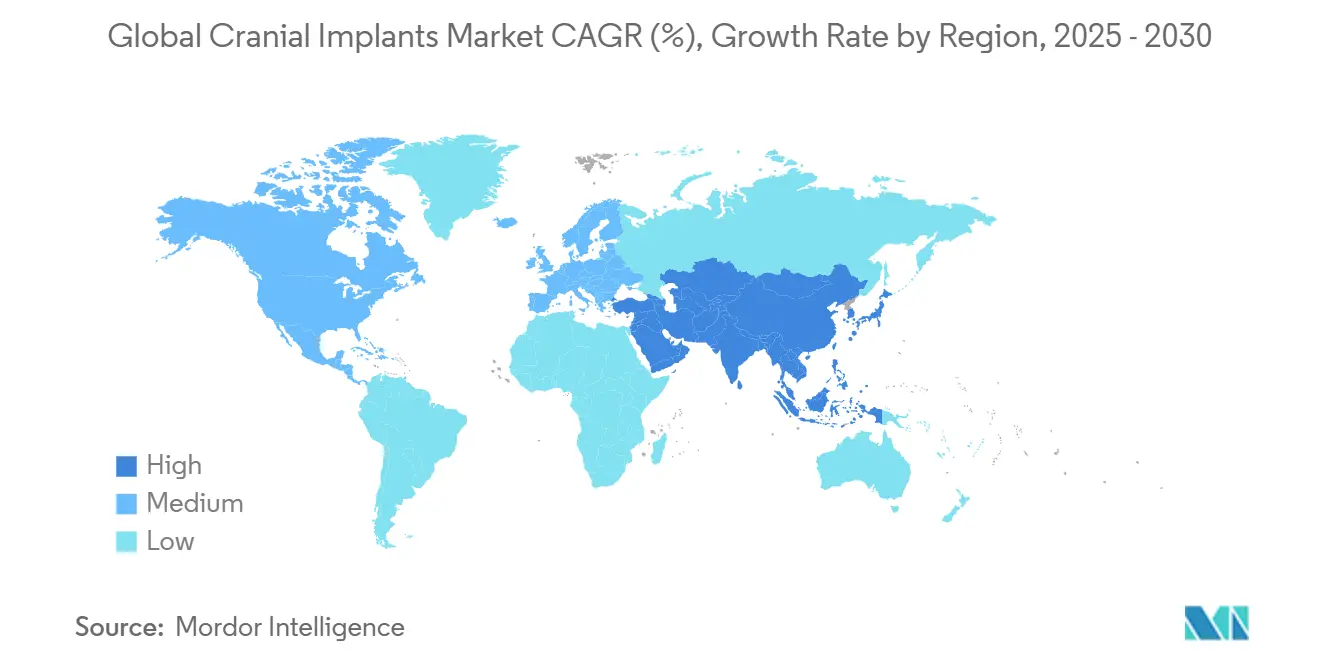
Competitive Landscape
The competitive arena shows moderate concentration. Stryker, Zimmer Biomet, and DePuy Synthes command leading shares through broad neurosurgical ecosystems. Stryker’s USD 4.9 billion acquisition of Inari Medical in January 2025 deepened its neuro-vascular toolbox and introduced cross-selling avenues for cranial plates[2]Source: Stryker Corporation, “Stryker Completes Acquisition of Inari Medical,” stryker.com. Zimmer Biomet’s 2024 purchase of Paragon 28 injected additive know-how that can migrate into cranioplasty workflows.
Specialist firms such as OssDsign and Xilloc design only patient-specific implants, differentiating on biomimetic ceramics and flexible service models. Renishaw invested GBP 50 million in 2024 to expand additive capacity and pilot augmented-reality navigation modules. Digital prowess is now a gating asset: suppliers that bundle scanning, planning, and printing software create sticky value propositions. Pediatric solutions and antimicrobial-coated plates remain white-space areas where smaller innovators could leapfrog incumbents. Meanwhile, impending patent expirations on standard titanium geometries invite low-cost entrants, accelerating commoditization in the lower tier of the cranial implants market.
Global Cranial Implants Industry Leaders
-
Stryker Corporation
-
Zimmer Biomet
-
KLS Martin Group
-
B. Braun SE
-
Johnson & Johnson Services Inc.
- *Disclaimer: Major Players sorted in no particular order
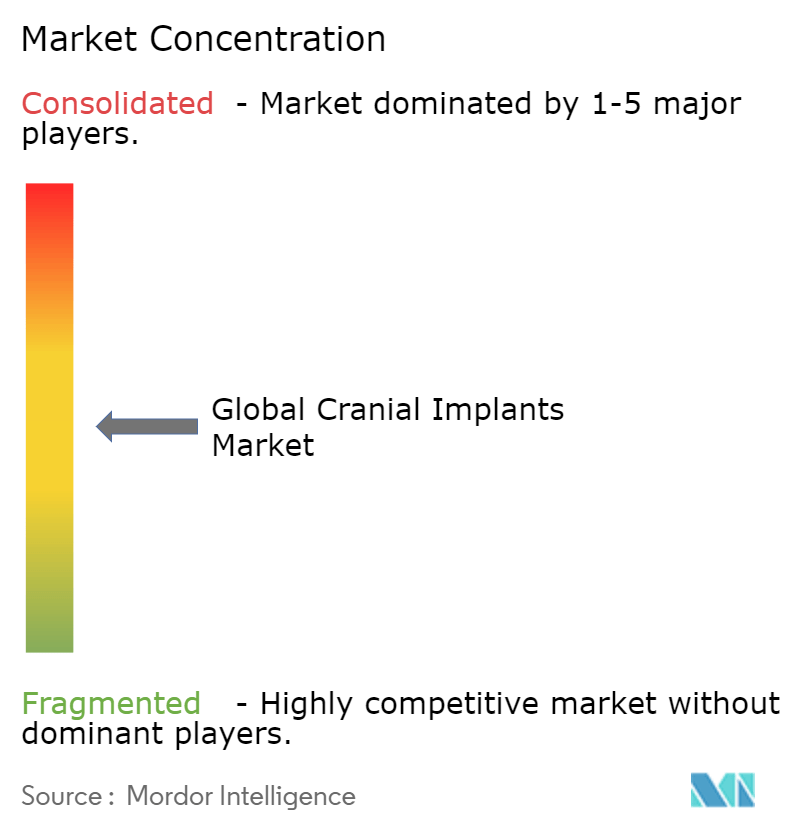
Recent Industry Developments
- January 2025: Stryker Corporation completed its USD 4.9 billion acquisition of Inari Medical, expanding its neurovascular portfolio.
- December 2024: Systems obtained FDA clearance for patient-specific PEEK cranial plates manufactured via additive processes
Global Cranial Implants Market Report Scope
As per the scope of the report, cranial implants are the devices used in cranioplasty, a surgical procedure used to reconstruct the defects or deformities of the skull caused by traumatic brain injury, ischemic diseases, or brain tumors. These implants are made up of biocompatible materials such as ceramics, metals, and polymers.
The cranial implants market is segmented by type, material, end-user, and geography. By type, the market is segmented into customized cranial implants and non-customized cranial implants. By material, the market is segmented into polymer, ceramic, and metal. By end-user, the market is segmented into hospitals and neurosurgery specialty centers. By geography, the market is segmented into North America, Europe, Asia-Pacific, the Middle East and Africa, and South America. The market report also covers the estimated market sizes and trends for 17 countries across major regions globally. The report offers the value (in USD) for the above segments.
| Titanium |
| Polyether-ether-ketone (PEEK) |
| Polymethyl-methacrylate (PMMA) |
| Hydroxy-apatite |
| Other Materials |
| 3-D Printed Implants |
| CAD/CAM-Milled Implants |
| Conventional Machined Implants |
| Hospitals |
| Specialty Neurosurgery Centers |
| Ambulatory Surgical Centers |
| North America | United States |
| Canada | |
| Mexico | |
| Europe | Germany |
| United Kingdom | |
| France | |
| Italy | |
| Spain | |
| Rest of Europe | |
| Asia-Pacific | China |
| India | |
| Japan | |
| South Korea | |
| Australia | |
| Rest of Asia-Pacific | |
| South America | Brazil |
| Argentina | |
| Rest of South America | |
| Middle East and Africa | GCC |
| South Africa | |
| Rest of Middle East and Africa |
| By Material (Value, USD Million) | Titanium | |
| Polyether-ether-ketone (PEEK) | ||
| Polymethyl-methacrylate (PMMA) | ||
| Hydroxy-apatite | ||
| Other Materials | ||
| By Technology (Value, USD Million) | 3-D Printed Implants | |
| CAD/CAM-Milled Implants | ||
| Conventional Machined Implants | ||
| By End User (Value, USD Million) | Hospitals | |
| Specialty Neurosurgery Centers | ||
| Ambulatory Surgical Centers | ||
| By Geography (Value, USD Million) | North America | United States |
| Canada | ||
| Mexico | ||
| Europe | Germany | |
| United Kingdom | ||
| France | ||
| Italy | ||
| Spain | ||
| Rest of Europe | ||
| Asia-Pacific | China | |
| India | ||
| Japan | ||
| South Korea | ||
| Australia | ||
| Rest of Asia-Pacific | ||
| South America | Brazil | |
| Argentina | ||
| Rest of South America | ||
| Middle East and Africa | GCC | |
| South Africa | ||
| Rest of Middle East and Africa | ||
Key Questions Answered in the Report
What forces are driving the fastest growth in the cranial implants market?
Rising traumatic brain injuries, expanding neurosurgical capacity in Asia-Pacific, and rapid adoption of 3-D printed patient-specific plates are the primary accelerants, supporting an 8.75% regional CAGR through 2030.
How do reimbursement policies influence adoption of customized implants?
Coverage gaps remain pronounced: U.S. Medicare’s USD 1,012.77 payment for cranioplasty falls well below the price of a custom PEEK plate, and France cut orthopedic hardware reimbursement by 25% in 2025, forcing hospitals to scrutinize cost-to-outcome ratios.
Which materials offer the best clinical performance today?
Titanium retains the widest clinical data set with osseointegration above 95%, while PEEK grows swiftly because of radiolucency and patient comfort advantages; hybrid constructs leverage strengths of both substrates.
What technological trend most disrupts incumbent manufacturing?
Additive manufacturing leads the shift, with 3-D printed implants expanding at 7.95% CAGR; AI-driven design optimization and point-of-care printers reduce lead times and enable complex geometries that boost bone integration.
Page last updated on:
